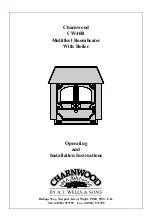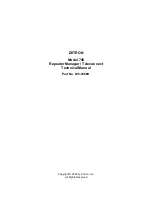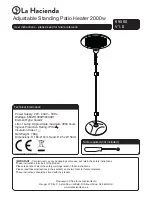
the tool supplied. The grate is put
into the wood position by moving the
tool in the direction of the arrow ‘W’
(marked on the handle of the tool)
until the tool is vertical. The grate is
put into the solid fuel position by
moving the tool in the direction of
the arrow ‘C’ until the tool is
horizontal.
If a mixture of wood and solid fuel,
or peat and solid fuel, is to be burnt
then keep the grate in the solid fuel
position.
LIGHTING
Set the grate into either the wood
position or the solid fuel position as
required. Place some paper and dry
kindling wood or fire lighters on the
grate and cover with a small amount
of fuel. Turn the thermostat control
knob to the maximum setting and
light the paper or fire lighters. Close
the doors and allow the fire to burn
until the fuel is well ignited then load
with more fuel and adjust the
thermostat to the required level.
On initial lighting, the fire may
smoke and give off an odour as the
silicon paint with which the firebox
is painted reacts to the heat. This is
normal and will cease after a short
time. In the meantime the room
should be kept well ventilated.
Before relighting the fire, riddle,
remove any clinker from the firebed
and empty the ashpan.
CONTROLLING THE
FIRE
The rate of burning and hence the
output is controlled by the control
knob on the left hand side of the
appliance. This is linked to a
thermostat which controls the boiler
temperature. The number at the top
of the knob is the number at which it
is set. Some experimentation may be
necessary to obtain the desired heat
output.
There is also a manual secondary air
control which is located below the
right hand side panel. When the arm
is pointing forwards it is closed,
when pointing to the right it is open
This control should be in the closed
position when burning most
smokeless fuels and in the open
position when burning coal, wood,
peat, anthracite, or homefire.
RUNNING THE FIRE
WITH THE DOORS
OPEN
The fire may be run with the doors
open. This will result in a reduction
in efficiency and hence heat output,
particularly to the boiler. The more
reactive fuels, like coal, homefire,
wood, and peat, will burn better when
the doors are open than fuels like
phurnacite, sunbrite and ancit.
For safety reasons use a spark guard
and do not leave the fire unattended
with the doors open.
SYSTEM CONTROLS
The heating system controls may
consist of time switches, room
thermostats, outdoor temperature
thermostats and thermostatic radiator
valves in virtually any combination.
These will work in conjunction with
the thermostat control on the
appliance. The thermostat on the
appliance will simply control the
temperature of the water coming from
the boiler and hence the temperature
of the radiators and domestic hot
water. The automatic controls (other
than thermostatic radiator valves)
will switch the pump (and hence the
radiators) on and off. Your installer
will be able to explain the controls
fitted to your system and how to
operate them.
ASH CLEARANCE
The ashpan should be emptied
regularly before it becomes too full.
The most convenient time to remove
the ash is just before riddling the fire
since the ash will then be at its
coolest. Use the tool provided to
remove the ashpan.
Never allow the ash to accumulate in
the ashpan so that it comes in contact
with the underside of the grate as this
will seriously damage the grate bars.
Ensure that the air inlet damper is
not prevented from closing by spilled
fuel or ash.
Care should be taken to ensure that
ash is cool before emptying it into
plastic liners or bins.
To make ash removal easier there is a
special
Charnwood ash carrier
available. This may be purchased
from your supplier or, in case of
difficulty, from ourselves.
RIDDLING
When burning solid fuels riddling
twice a day is usually sufficient.
When burning wood or peat, ash
should be allowed to build up and
generally riddling every other day
will be sufficient.
The fire should be riddled with all
doors shut. Place the tool on the knob
and rotate between the horizontal and
the 45 degree position several times.
When burning wood or peat do not
riddle all the ash into the ashpan,
keep a layer about 12 mm (1/2 inch)
thick on the grate.
Caution: when riddling the grate
using solid fuel do not go beyond the
45 degree position as this can cause
the grate to jam.
If jamming does occur then the fire
should be allowed to burn for
approximately half an hour before
riddling the grate again as described
above.
Too much riddling can result in
emptying unburnt fuel into the
ashpan and should therefore be
avoided. Clinker should regularly be
removed from the firebed.
After riddling, the grate should be
put back into the solid fuel or wood
Page 4
CW40B 3/95




























